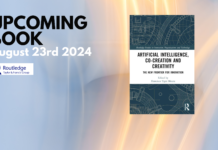Artificial creativity is an exciting and timely topic.
It is currently being studies by academics from various areas, such as marketing, computer science, psychology, design, finance, medicine and many more.
The applications of artificial creativity rage from music, to the stock market, product development, literature, and even education.
Here, I present a selection of publications on the topic ranging from 2018-2001. The list involves conference papers, books, books chapters and scientific articles.
It is divided into three periods: 2018-2013; 2012-2007; and, 2006-2001. During each of these “time-blocks”, papers are listed in alphabetical order.
AND PLEASE NOTE: This is not a definite list. it is based on my subjective appreciation for each one, as they have helped me and triggered my fascination on the topic.
Also, I have gathered a list of interesting videos on artificial creativity, have a look as well! In case you are writing a research paper on the topic or a thesis (bachelor, Masters or PhD), I honestly hope that both lists can help you.
But for now, here we go!
Publications: 2018-2013
- Augello, A., Infantino, I., Maniscalco, U., Pilato, G., Rizzo, R., & Vella, F. (2018). Robotic Intelligence and Computational Creativity. Encyclopedia with Semantic Computing and Robotic Intelligence.
- Besold, T. R., Schorlemmer, M., & Smaill, A. (Eds.). (2015). Computational creativity research: towards creative machines. Atlantis Press.
- Chamberlain, A. (2017, August). Are the Robots Coming?: Designing with Autonomy & Control for Musical Creativity & Performance. In Proceedings of the 12th International Audio Mostly Conference on Augmented and Participatory Sound and Music Experiences (p. 54). ACM.
- Dartnall, T. (Ed.). (2013). Artificial intelligence and creativity: An interdisciplinary approach (Vol. 17). Springer Science & Business Media.
- Ellis, S., Haig, A., Bringsjord, S., Valerio, J., Braasch, J., & Oliveros, P. (2015). Handle: Engineering artificial musical creativity at the “trickery” level. In Computational Creativity Research: Towards Creative Machines (pp. 285-308). Atlantis Press, Paris.
- Ferrucci, D., & Bringsjord, S. (2017). Artificial intelligence and literary creativity: inside the mind of BRUTUS, a storytelling machine.
- Fu, K., Fuge, M., & Brown, D. C. (2018). Design creativity. AI EDAM, 32(4), 363-364.
- Gruner, D. T., & Csikszentmihalyi, M. (2019). Engineering Creativity in an Age of Artificial Intelligence. In The Palgrave Handbook of Social Creativity Research (pp. 447-462). Palgrave Macmillan, Cham.
- Hein, A. M., & Condat, H. (2018). Can Machines Design? An Artificial General Intelligence Approach. arXiv preprint arXiv:1806.02091.
- Kurt, D. E. (2018). Artistic Creativity in Artificial Intelligence.
- Norton, D., Heath, D., & Ventura, D. (2013). Finding creativity in an artificial artist. The Journal of Creative Behavior, 47(2), 106-124.
- Olteţeanu, A. M., Falomir, Z., & Freksa, C. (2018). Artificial cognitive systems that can answer human creativity tests: An approach and two case studies. IEEE Transactions on Cognitive and Developmental Systems, 10(2), 469-475.
- Quintana, C. S., Arcas, F. M., Molina, D. A., Rodriguez, J. D. F., & Vico, F. J. (2013). Melomics: A case-study of AI in Spain. AI Magazine, 34(3), 99-103.
- Yakut, M. Z. (2018, June). The Issues of Humanoid Robots with Artificial Creativity in terms of Cultural Heritage and Art. In IOP Conference Series: Materials Science and Engineering (Vol. 364, No. 1, p. 012012). IOP Publishing.
- Warner, T. (2017). Pop Music-Technology and Creativity: Trevor Horn and the Digital Revolution. Routledge.
- Wiggins, G. A., Tyack, P., Scharff, C., & Rohrmeier, M. (2015). The Evolutionary Roots of Creativity.
- Zbikowski, L. M. (2018). Conceptual blending, creativity, and music. Musicae Scientiae, 22(1), 6-23.
Publications: 2012-2007
- Bown, O. (2012). Generative and adaptive creativity: A unified approach to creativity in nature, humans and machines. In Computers and creativity (pp. 361-381). Springer, Berlin, Heidelberg.
- Colton, S., & Wiggins, G. A. (2012, August). Computational creativity: The final frontier?. In Ecai (Vol. 2012, pp. 21-16).
- Gervás, P. (2009). Computational approaches to storytelling and creativity. AI Magazine, 30(3), 49.
- Jennings, K. E. (2010). Developing creativity: Artificial barriers in artificial intelligence. Minds and Machines, 20(4), 489-501.
- Lock, G. (2011). Musical creativity in the mirror of Glaveanu’s five principles of cultural psychology. Culture & Psychology, 17(1), 121-136.
- McCormack, J. (2008). Facing the future: Evolutionary possibilities for human-machine creativity. In The Art of Artificial Evolution (pp. 417-451). Springer, Berlin, Heidelberg.
- McCormack, J., & d’Inverno, M. (2012). Computers and creativity: The road ahead. In Computers and creativity (pp. 421-424). Springer, Berlin, Heidelberg.
- Memmert, D., & Perl, J. (2009). Analysis and simulation of creativity learning by means of artificial neural networks. Human Movement Science, 28(2), 263-282.
- Riedl, M. O., & O’Neill, B. (2009). Computer as audience: A strategy for artificial intelligence support of human creativity. In Proc. CHI Workshop of Computational Creativity Support.
- Romero, J. J. (2008). The art of artificial evolution: A handbook on evolutionary art and music. Springer Science & Business Media.
- Saunders, R. (2012). Towards autonomous creative systems: A computational approach. Cognitive Computation, 4(3), 216-225.
- Schmidhuber, J. (2010). Formal theory of creativity, fun, and intrinsic motivation (1990–2010). IEEE Transactions on Autonomous Mental Development, 2(3), 230-247.
- Schmidhuber, J. (2010). Artificial scientists & artists based on the formal theory of creativity. In Proc. 3rd Conf. on Artificial General Intelligence. Advances in Intelligent Systems Research (Vol. 10, pp. 145-150).
- Sinha, P. (2008). Artificial composition: an experiment on Indian music. Journal of New Music Research, 37(3), 221-232.
- Trausan-Matu, S. (2010). Computer support for creativity in small groups using chats. Annals of the Academy of Romanian Scientists, Series on Science and Technology of Information, 3(2), 81-90.
Publications: 2006-2001
- Barnes, J. M. (2004). Creativity and composition in music. In Issues in music teaching (pp. 101-113). Routledge.
- Bown, O., & Wiggins, G. A. (2005). Modelling musical behaviour in a cultural-evolutionary system. In Proceedings of the IJCAI (Vol. 5).
- Bringsjord, S., Bello, P., & Ferrucci, D. (2003). Creativity, the Turing test, and the (better) Lovelace test. In The Turing Test (pp. 215-239). Springer, Dordrecht.
- Colton, S., Pease, A., & Ritchie, G. (2001). The effect of input knowledge on creativity. Technical Reports of the Navy Center for Applied Research in Artificial Intelligence.
- Conklin, D. (2003, April). Music generation from statistical models. In Proceedings of the AISB 2003 Symposium on Artificial Intelligence and Creativity in the Arts and Sciences (pp. 30-35).
- Cope, D. (2004). Virtual music: computer synthesis of musical style. MIT press.
- Dietrich, A. (2004). The cognitive neuroscience of creativity. Psychonomic bulletin & review, 11(6), 1011-1026.
- Etxeberria, A. (2002). Artificial evolution and lifelike creativity. Leonardo, 35(3), 275-281.
- McCormack, J. (2005, March). Open problems in evolutionary music and art. In Workshops on Applications of Evolutionary Computation (pp. 428-436). Springer, Berlin, Heidelberg.
- Saunders, R. (2002). Curious Design Agents and Artificial Creativity-A Synthetic Approach to the Study of Creative Behaviour.
- Saunders, R., & Gero, J. S. (2002, October). How to study artificial creativity. In Proceedings of the 4th conference on Creativity & cognition (pp. 80-87). ACM.
- Saunders, R., & Gero, J. S. (2001). Artificial creativity: A synthetic approach to the study of creative behaviour. Computational and Cognitive Models of Creative Design V, Key Centre of Design Computing and Cognition, University of Sydney, Sydney, 113-139.
- Siau, K. (2003). E-Creativity and E-Innovation. In The International Handbook on Innovation (pp. 258-264).
- Todd, P. M., & Miranda, E. R. (2003). Putting some (artificial) life into models of musical creativity. In Musical creativity: Current research in theory and practise.
- Wiggins, G. A. (2001). Towards a more precise characterisation of creativity in AI. In Case-based reasoning: Papers from the workshop programme at ICCBR (Vol. 1, pp. 113-120).
Final Thoughts
So there you go, years of science and research compiled on a list.
In case you were searching for literature on artificial creativity, I hope my list here has helped you. But do not forget to keep on searching. There are many other publications that could have been added here and that were not.
As I mentioned before, this is simply a list of publications I have gathered along the years and that for some reasons have interested me. I am sure there is much more out there!
Turn it up!






